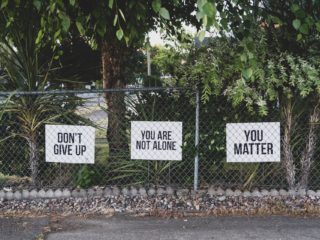For those of you who haven’t been following, your head is full of drunk, restless monkeys. In fact, it’s not just you – it’s all of us. We are all nurturing those little trouble-makers, constantly, and we need to know how to accept them, learn from them and tame them. And I’ve already told you this before but here it is again: single them out, one by one, listen to what they have to say, and understand their significance in your composition as a living, breathing, human being. Trust me. They will make your lives a whole lot easier if only you gave them the time of day. By understanding what it is that makes them tick, you hold the secret to inner peace in the palms of your own hands.
And the same goes the other way – “when you go about attaching your happiness, your existence and your life’s meaning too deeply with your work, your relationships or anything else for that matter, you put yourself at risk. Why? Because with attachment comes a very strong urge to control the circumstances. While you can exercise some amount of control over what happens in your life, that will absolutely never eliminate the possibility of things going differently than planned,” Shreya Dalela writes.
This is where the detachment theory comes in – and with theory comes practice. I first read about this years ago in one of my all-time favorite true story novels by Mitch Albom: Tuesdays with Morrie, and it’s lately been resonating as the ultimate life philosophy to me.
Detachment, by theory and through practice is achieved only when you accept a sensation, a feeling, a phase… fully. Delving into that one emotion you’re trying so hard to avoid is the key to knowing how you react, what you consider as triggers when you’re feeling that feeling – and ultimately, how to turn it off. How to predict how it ends, and how to stop it from taking the wrong turn and costing you later.
If for example, you’re dealing with loneliness, what you need to do is let go and dive into it completely, let your guards down and the tears flow. But observe how you’re dealing with the world around you – who you’re reaching out to, if you’re doing something you wouldn’t be doing normally, if you’re extra sensitive or aggressive or withdrawn – and notice how these things, and the things you’re doing, make you feel. Eventually, you should be able to say “All right, that was my moment with loneliness. I’m not afraid of feeling lonely, but I’m going to put that loneliness aside and know that there are other emotions in the world, and I’m going to experience them as well,” according to Schwartz.
Tuesdays with Morrie is a real story, starring the (100% real) Sociology Professor Morrie Schwartz. After discovering he was dying, Mitch Albom – the author of the book who also happens to be a previous student of his, decided to reach out and start meeting him on Tuesdays, same as they did years ago when he was an undergraduate. What started out as a potential eulogy and ended up as a bestselling novel, categorizes Schwartz’s life lessons in chapters. One of them was on Detachment.
According to Schwartz, “By throwing yourself into [said] emotions, by allowing yourself to dive in, all the way, over your head even, you experience them fully and completely. You know what pain is. You know what love and grief are. And only then can you say ‘all right. I have experienced that emotion. I recognize that emotion. Now I need to detach from that emotion for a moment.”
As written by internationally recognized writer and teacher of meditation and yoga philosophy, Sally Kempton, these are the four stages of detachment leading to a fifth of liberation:
Stage 1: Acknowledgment
Acknowledgment doesn’t just mean recognizing that you want something badly or that you’re feeling loss, for example. When you want something, feel how you want it—find the wanting feeling in your body. When you’re feeling cocky about a victory, be with the part of yourself that wants to beat your chest and say, “Me, me, me!” Rather than pushing away the anxiety and fear of losing what you care about, let it come up and breathe into it. And when you’re experiencing the hopelessness of actual loss, allow it in. Let yourself cry.
Stage 2: Self-Inquiry
Once you’ve felt your feelings, you’ll need to process them through self-inquiry. To do this, start by exploring your “feeling space” that the desire or grief or hopelessness brings up in your consciousness, perhaps naming it to yourself, and gradually breathing out the content, the storyline.
It sometimes helps to talk to yourself for a while beforehand, to take care of the part of you that needs comforting. Remind yourself that you do have the resources, you can recall helpful teachings, you can even use this time to pray for help and guidance, or simply say, “may I be healed,” with each exhalation.
Stage 3: Processing
In the third stage of detachment, you begin to become aware of what has been useful in the journey you’ve just taken, in the task or relationship or life stage you’re working with, regardless of how it all turned out. Many of us reach the third stage of detachment when we realize that we have actually gained something, even if it’s just a lesson in what not to do.
Feelings can be processed using a combination of – relatively customizable – tactics: mindfulness: it’s just a thought, talking back to it: things will get better, and specific prayer: the strength to deal with this.
Stage 4: Creative Action
Loss or desire can paralyze us, so that we find ourselves without the will to act or else acting in meaningless, ineffective ways. One of the reasons we take time to process is so that when we do act, we’re not paralyzed by fear or driven by the frantic need to do something (anything!) to convince ourselves we have some degree of control. In the early stages of loss, or in the grip of strong desire, it is sometimes better just to do the minimum for basic survival. As you move forward in the processing, however, ideas and plans will start to bubble up inside you, and you’ll feel actual interest in doing them. This is when you can take creative action.
Stage 5: Freedom
True liberation. You’ve reached this stage when thinking about your loss (or the thing you desire) doesn’t interfere with your normal feelings of well-being. Desire, fear, and hopelessness are deeply embedded in our psyches, and we feel their pull whenever any remnant of attachment exists. We know that we’ve begun to achieve real detachment in a situation when we can contemplate what’s occurring without immediately getting blindsided by these feelings.
Every time we free ourselves from one of those sticky feelings, we unlock another link in what the yogic texts call the chain of bondage.
Learning how to detach yourself from a feeling can take a bit of time, but when you get the hang of it, you’ll find it so much harder for your emotions or thoughts to control you. And when you’re in the driver’s seat, you’re bound to have a nice, happy journey only to arrive healthy, safe and sound.
Have something to say? Join the conversation in our Facebook group!
Feel free to subscribe to our weekly newsletter to get the latest releases on all our articles & episodes for our exclusive mental health podcast series, with celebrity guests sharing their take on Mental Health and Wellbeing.








